The Middle Ages are associated with general battles, during which knights in full armor, eagerly and with a song on their lips, went into battle, the earth was flowing with blood, and the corpse was littered densely. However, great battles were rare. In addition, they looked completely different than we imagine today.
When it comes to battles, the Middle Ages are a special time. However, despite everything, they were not a common occurrence. Moreover, the strategy of the time was primarily to… avoid confrontation , and in response to the raid - closing behind fortifications. Effects? A slow march of attackers and fierce defense of the attacked. Most often, it was simply a war of exhaustion, in which the combatants sought, above all, for the fastest material gains.
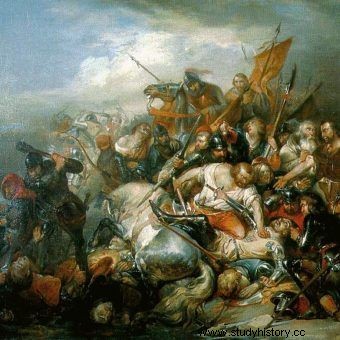
Medieval battles often turned into bloody massacres. This was the case, for example, at Courtrai.
Thus, the vast majority of the army's time was to plunder towns and villages, organize ambushes and emergency raids, and conduct sieges. Battles did happen, but medieval wars were mainly about undermining the economic foundations of the enemy. An example of such activities was the parade of William the Conqueror in the years 1068–1069 . It was similar with the crusades, and even the Polish-Lithuanian-Teutonic struggles or the Hundred Years' War.
The silence of sources
How does this relate to the modern image of brave knights going to death without hesitation and beating to the last drop of blood? Well, there is a grain of truth in stereotypes about medieval battles. In fact, when the final decisions were reached, they were usually extremely bloody and ruthless .
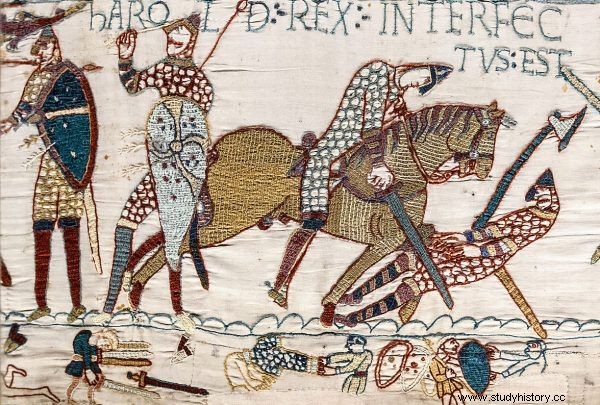
There was a lot of dead bodies on the medieval battlefields.
However, when trying to describe them, we come across difficulties already at the stage of determining the number of fighting parties. The information provided by historians was usually greatly exaggerated. In fact, it was a rule to multiply the opponent's forces in order to emphasize the importance of one's own victory or to explain the defeat.
Also, the depictions of the battles themselves are not very precise. While the general descriptions may roughly correspond to the truth, there is already a problem with the details. For the most part, chroniclers were not interested in the details of the fight - or simply did not know about them. Also, the direct effects of clashes - and therefore also data on losses on both sides - were often exaggerated or, on the contrary, understated.
It also happens that the image of the battle emerges not directly from written sources, but from research on topography, armaments and military tactics in a given period. And only the effects of these works, together with enigmatic chroniclers, give an idea of the scale of the battle as such.
The best example is the clash of the forces of Prince Mieszko I with the troops of the Lusatian margrave Hodon at Cedynia on June 24, 972. From the so-called "silence of sources", historians conclude that it was an extremely bloody battle - or at least the aftermath was bloody. Because, as a result of deliberate actions of the princely troops, the margrave lost all the best knights and barely escaped from oppression himself. We do not even know the approximate number of victims. However, it must have been significant, as even Emperor Otto I himself was "thrown alive at the news of this defeat".
Wading to your ankles in blood…
However, battles are not everything. Medieval warfare very often took the form of a siege. Due to the high costs of such undertakings, efforts were made to minimize the time needed to conquer the fortresses. Moreover, the longer the besieged resisted, the more they faced terrible consequences in the event of a defeat . It was no different after the siege of Jerusalem by the Crusaders in 1099, which lasted over a month. The conquerors in a bloody frenzy, ignoring the orders of their commanders, murdered the city's defenders for two days.
The number of victims is difficult to establish. Estimates range from 3,000 to 10,000 according to Frankish and Hebrew sources, and even 70,000 according to Muslim reports . Regardless of what the truth may be, the descriptions of "wading up to your ankles in blood", almost "a whole city full of corpses" and a temple "flowing with streams of blood" of its defenders are impressive to this day.
However, anyone who would see the sources of such terrifying war practices only in cultural and religious antagonisms would be wrong. Fighting under the same sign of the cross - and in addition adhering to the chivalrous ethos - soldiers were able to deal with their enemies equally cruelly. On July 15, 1410, over 50,000 armed men clashed at Grunwald. The fight for the name of God (and with his help) did not prevent Jagiełło's army from setting up a bloodbath for the Teutonic forces . And this with many times lower own losses.
As it is assumed, the Order's army lost up to 8,000 knights, squires and armed henchmen in battle, during the defense of the rolling stock and the flight - which was about half the number of men before the clash. As the chronicler writes:"[...] the road was littered with corpses for a few miles, and the earth stuck with blood ; dying cries and groans were heard in the air. ”
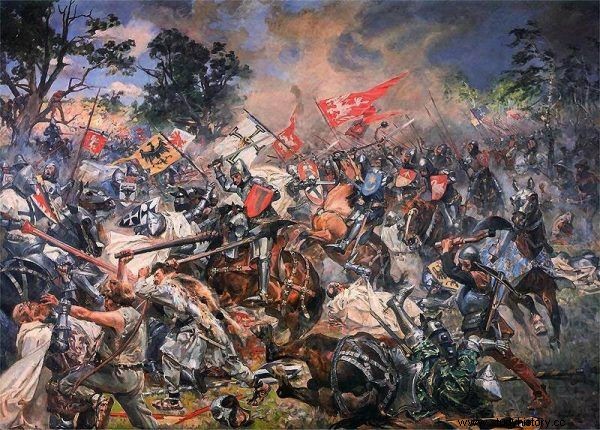
At Grunwald, the Teutonic Knights lost about 8,000 knights, squires and armed henchmen.
The same thing happened a few months later in the Battle of Koronowo. The clash was initially conducted according to all the rules of knightly law and tournament duels. The fighters stopped the struggle twice to rest, exchange prisoners and horses, and send gifts from one another. The image of the battle, however, changed radically when the Polish knight took over the Teutonic Order . This broke the morale of the opponent who started to flee. Polish knighthood then:
[…] , having won a full victory and lowered the enemies, killed them, captured them, or forced them to flee. The enemy withdrew, and then, when the Poles attacked more severely, he turned to flee. [...] The victors also chased the escapees, as long as they had enough strength to pursue and kill hands .
We do not have precise data on losses in this case either, but it is estimated that the monks lost about 800 killed and 300 captured.
Ethos? It's not for commoners!
The battles of the promoters of the knightly ethos, who were by definition more profitable to capture the opponent and receive a lavish ransom than to kill them, could be brutal. However, the most dangerous opponent of the professional European warriors turned out to be the plebeians they scorned and disregarded.
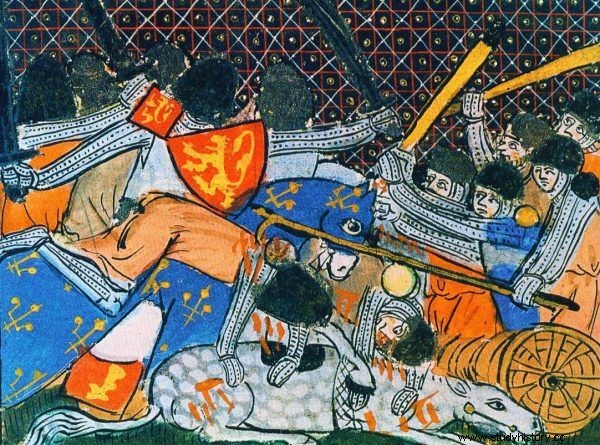
14th century depiction of the Battle of Courtrai.
Here is because on July 11, 1302 near Courtrai in Flanders the insurgent army of city weavers smashed and massacred the elite of the French knights Philip IV the Beautiful . Pikes and clubs (godendagi) in the hands of the Flemish infantry became a terrible weapon. The charging royal armed forces were unsuccessfully slaughtered by the insurgents. The losses of weavers are estimated at around 200, French - at over 1,500 people. The most spectacular prey of the rebels was 500 pairs of golden spurs torn off the knights' legs.
The previously mentioned Hundred Years' War was also not without bloody clashes, to mention one of them fought at Crécy on August 26, 1346. At the outset, there was a peculiar duel between English archers and Genoese crossbowmen on French service. Unfortunately for the French mercenaries, the duel ended tragically. As reported by the chronicler:
archers they started firing their arrows with such force and speed that it seemed like snow was falling . When the Genoese felt the arrows piercing their arms and heads and piercing their armor […] they turned back and fled .
The shelled and decimated crossbowmen fell under the horses of the rushing French knights. It was approved by the King of France, Philip VI himself, who encouraged his soldiers to fight, shouting:"Kill these rogues so that they will not disturb us!" But it was of no avail. The repeated charges of the French were successfully held back by the plebeian archers and hurried knights of Edward III.
According to the account, "[...] sharp arrows pierced people and horses. Many fell and in the crowd they could not get up. " The battlefield was littered with the bodies of 10-20,000 French and Genoese, including as many as 1,500 knights. The King of England lost a maximum of 500 combatants.
Struggle for destruction
While the fierce fighting between hostile powers is less surprising, it is difficult to comprehend the bestiality in fratricidal clashes . Unfortunately, history knows many cases when one's own compatriots were treated even more cruelly than foreigners. This was the case on March 29, 1461, at the Battle of Towton during the War of the Roses. The decision of both sides not to take prisoners turned the skirmish into a bloody mess.
Approximately 28,000 people died in the battle to become King of England . This accounted for more than half of all the forces involved in the fight. Bordered by swamps, mountains and rivers, the battlefield was crowded under constant fire from archers and firearms. The Lancasters suffered the worst losses - especially during their hasty retreat.
The chronicles say that "they threw off their helmets, armor and shields in order to be able to escape faster." However, without adequate protection, they were only more vulnerable to the blows inflicted by Yorks pursuing them. Bridges formed from the bodies of the fallen on the river through which the retreating armed men had to cross . Captured prisoners were mutilated, their ears and noses were cut off. It was an expression of sheer cruelty - because they would be executed anyway.
Henry V, who was captured in the Battle of Agincourt in 1415, had an equally brutal fate and sentenced them to beheaded. It is true that English knights refused to take such a shameful and unprofitable act, but plebeian archers had no problem with it. The same was the case with the Saracens taken prisoner at Akka in 1191. In view of the violation of the terms of the truce by Saladin, the King of England, Richard the Lionheart, ordered the killing of 2,700 hostages. According to sources, the soldiers relished the murder, which they treated as an act of revenge for the deaths of comrades during a long siege.
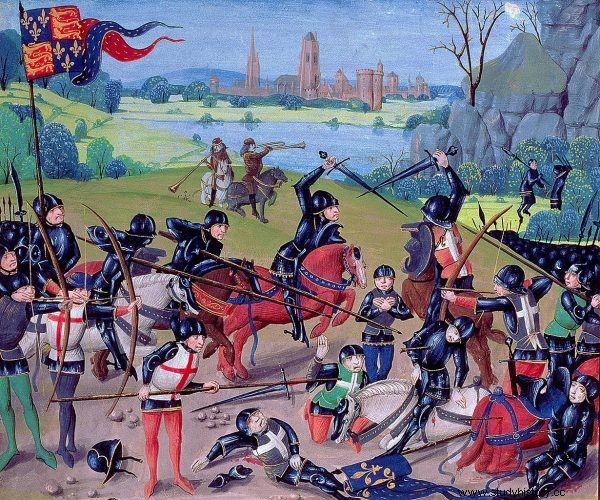
During medieval battles, there were cases of murdering prisoners, and this was also the case, for example, at Agincourt.
As you can see, the battles of the Middle Ages were mostly battles of destruction . It should also be remembered that medical assistance practically did not exist at that time. So, more than once, even a small wound or fracture ended in death, which additionally increased the number of casualties and made the battlefield even bloodier.
It didn't matter whether the opponent believed in God or Allah. Even social status did not protect against death in battle (and sometimes even turned into a sentence). The desire for profit for the captured prisoner often died in the frenzy of battle. Whether a given knight was able to survive often depended simply on the circumstances, determination and ingenuity of the antagonists. And the latter was certainly not lacking in our medieval ancestors.
***
You can read about the successes of our weapon in the book “Polish triumphs. 50 glorious battles in our history ” . Learn about the clashes that changed the course of history with this richly illustrated publication. From victorious fights in the times of Bolesław the Brave, to fierce battles in World War II. Successes that every Pole should remember. Buy today with a discount at empik.com ,
